WHAT THE STRESS…
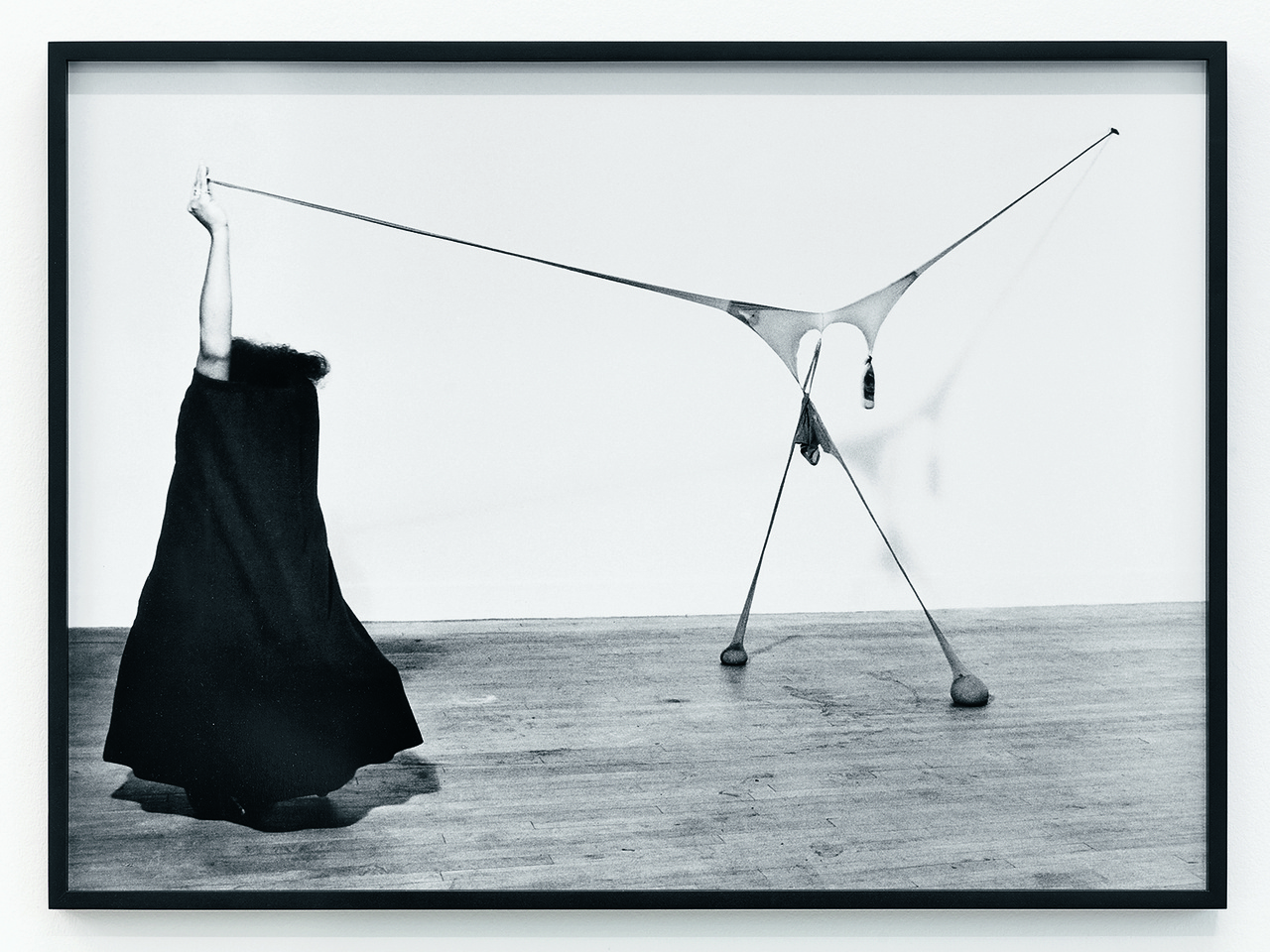
Senga Nengudi, studio performance with “R.S.V.P.,” 1976
How to respond, in a moment that feels less post-medium than simply over the question of medium altogether, to a prompt asking for writing about sculpture? I don’t think of myself as a sculpture person or even a medium person. At most, I am a person interested in mediums entered and disrupted by others or by complicating factors they entail: I like talking about negative spaces in installations and about artists who specialize in formats such as vitreous enamel fired on steel, or slideshows, or painting invaded by printmaking, or dance inside museums. [1] Still, it isn’t that I don’t like or indeed don’t try to think about sculpture. When I begin to really think about it, my “taste” in sculpture bends toward that which lays waste to any doubts about its anthropomorphism: Isa Genzken, Rachel Harrison, Nairy Baghramian, Senga Nengudi. What I particularly like is how these artists turn the anthropomorphism of sculpture back into a reflection of what the human is or could be. [2]
Let me explain a little. When sculptors such as Harrison or Genzken convert the vertical format of statues to respond to their unexpected second life as storage systems – here, I am thinking particularly of Harrison’s stacked configurations but also works as simple as Genzken’s Urlaub (2004) – they renegotiate the wall-plane that defines museal experience, as well as the simple idea of a bounded figure. In turn, we are made to face the strange modes of embodiment forced on us by culture or, via Nengudi’s sac-like rhizomes or Baghramian’s hinged joints, to rethink them. When these artists turn to mannequins, to the horizontal plane of the ellipsoid, to grids, or to webbing, they let the “us” implied by their work spread over the most and least anthropocentric shapes and voids, sometimes conflating those extremes. [3] In that range that alternately constricts and dilates, we start to learn where life-forms can be seen to lose their precise edges. In place of those edges, we start to see where we are implicated by the often-invisible support systems that make us, as living beings, both different and like mannequins, grids, ellipsoids, sacs – or, different and yet comprehensive of such forms: requiring them, in the same ways that we are storage systems.
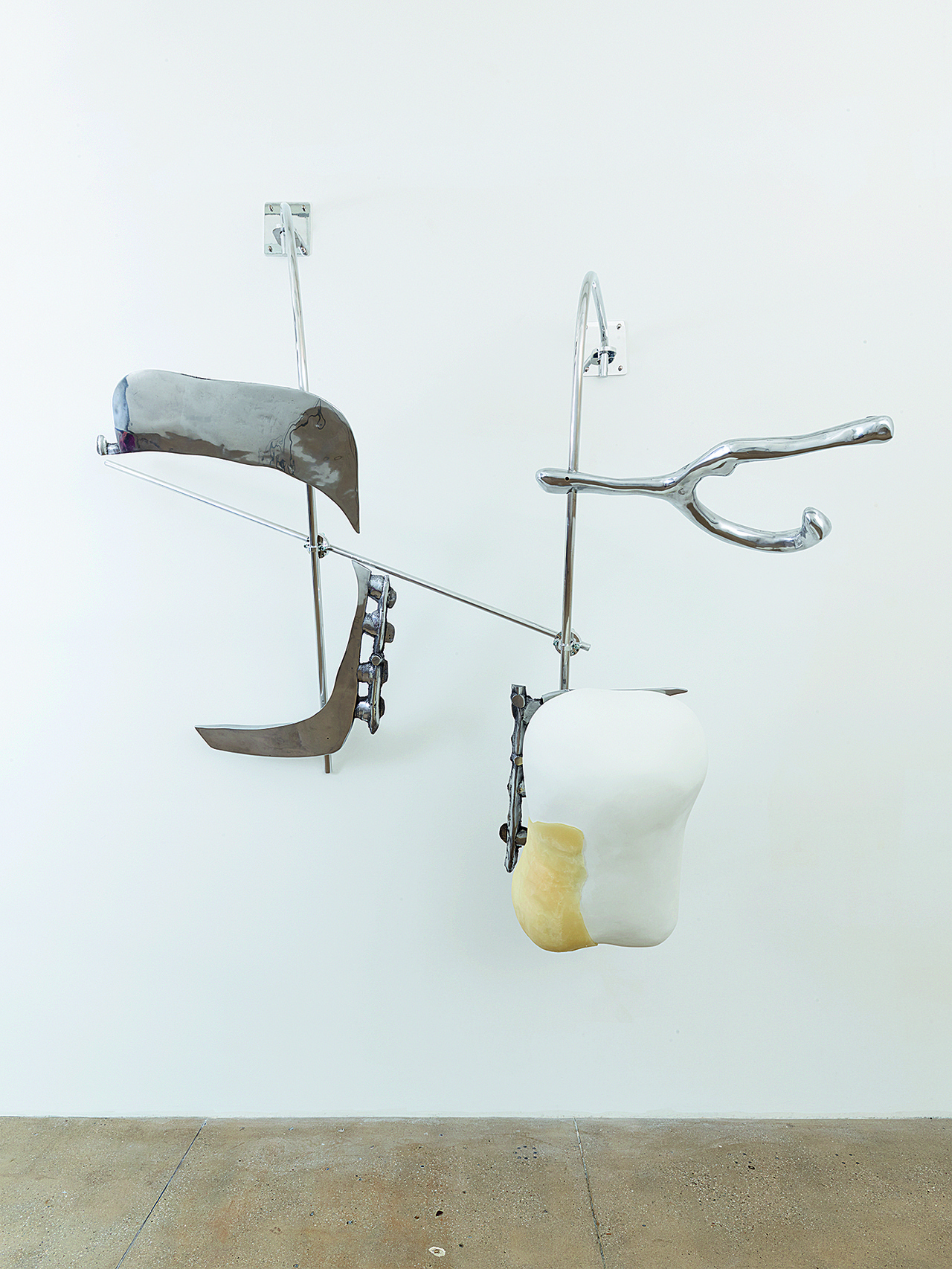
Nairy Baghramian, “Scruff of the Neck (UL 11, F),” 2016
Finally, trying to think as a “we” means that that pronoun has to constrict and dilate in order to be of any service. To quote another beloved sculptor, Liz Larner: “I like to think of the viewer’s experience as an encounter, which accounts for the preciseness of any one life-form or thing being in a particular place at a certain moment in time. …Also, different bodies with varying ways of moving encounter sculptures.” [4] Can sculpture constitute a “we” from “different bodies with varying ways of moving”? Let’s not give in to a faltering and potentially empty gesture at inclusivity. Let’s instead hear Larner describe how bodies and their movements might themselves deliver ambiguity to the questions of “preciseness” that haunt this medium overdetermined by its too-physical, too-physically-manifest edges. Painting can confront its frames, and performances their beginnings and endings. Sculpture’s relation to boundedness is notoriously vague. An encounter that opens out from those “varying ways of moving” begins to describe the terms of preciseness and probably makes that preciseness behave differently. Sculpture, that medium whose very edges are either central to our sense of being (either like this thing) or not might also be the medium to help us rethink our own boundaries. Like Dan Flavin’s lit-up rods, they might blur.
I realized, in preparing this essay, that my understanding of the medium was shaped at a formative stage by Lawrence Weiner’s claims that works that he painted on flat walls are sculpture. Famously, his statement/sculptures, as Birgit Pelzer calls them, built out lexical, grammatical, and diacritical associations that materialize space and motion, concept and counterweight, as well as their interrelationships. [5] In Weiner’s words, however, sculpture would get us to objecthood: “I see ‘sculpture’ as a word that most people … perhaps it’s a placatory gesture on my own part, but it’s a word that most people can relate to as a material way of human beings relating to objects.” [6] To me, sculpture is a circuitous pathway to get humans to think about objects, which it seems to me we think about plenty. Rather than thinking of an encounter as a question of perception, attention, and understanding – the tenets of a Minimalist worldview – we/he could be asking a question about “a material way of human beings relating.”
If we are willing to let go of objects, as I propose, then we can open up the question of to whom or what and how “we” relate.
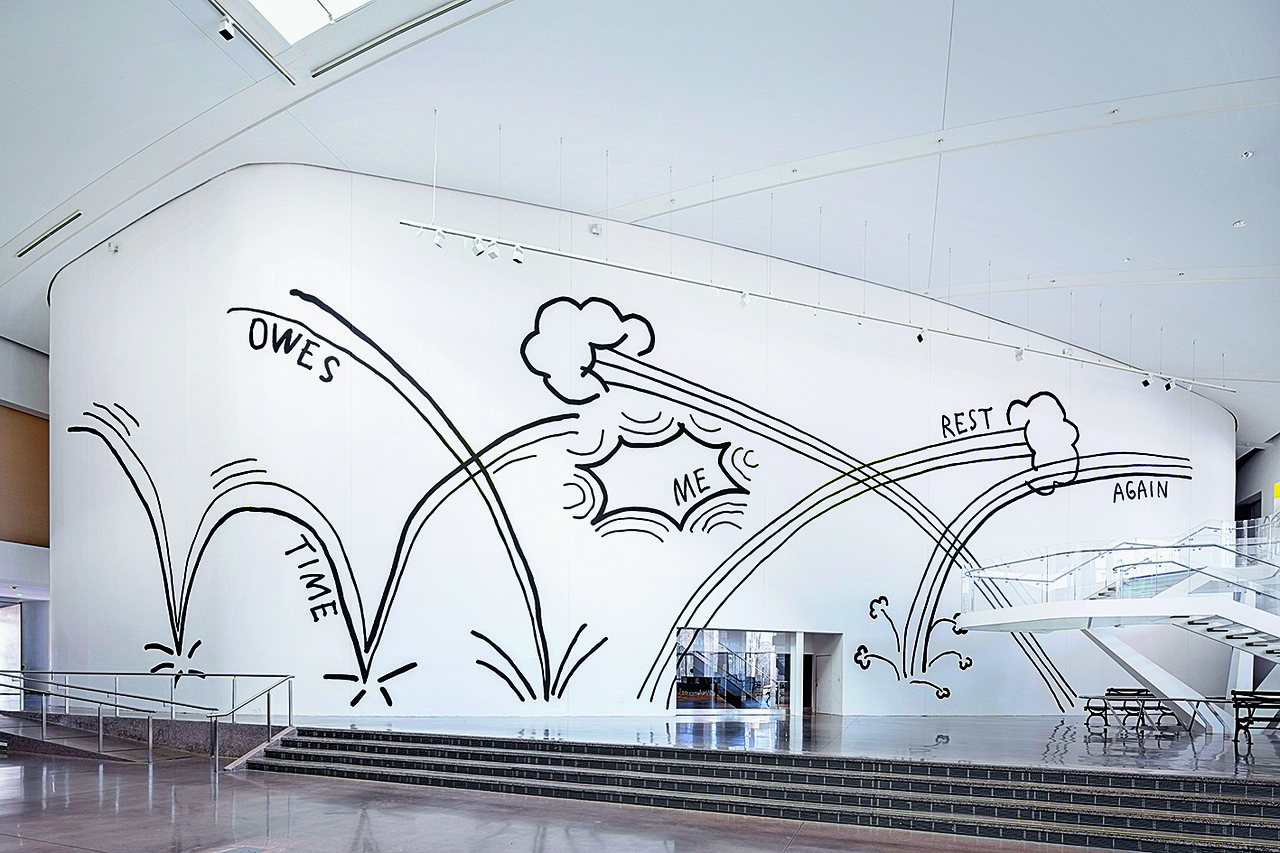
Christine Sun Kim, “Time Owes Me Rest Again,” 2022
Lately, I’ve been noticing how Christine Sun Kim’s wall-bound works might invigorate my revision of Weiner’s claim. Often, her words, shapes, and lines turn walls into drawings or bounce across them, their meanings sometimes verified or contested by mounds of colored-in black shapes or urged on by arrows and motion lines. We see something apparently conceptual and linguistic with these aids. Moreover, the form of the viewer as a composite of supports and languages – not the language, the one that supposedly defines us, but dozens of others – shifts not just what but how we see. Thus, Kim’s mural Time Owes Me Rest Again, installed at the Queens Museum in 2022, draws the words “time” and “owes” sinking down and the words “rest” and “again” jumping up, disappearing, evanescing. Cartoonish puffs (as in “this thing has just disappeared”) and star-like indicators of the impact of something landing help us see the words move, while arcing motion lines on the museum’s giant curved wall suggest that this pattern repeats over and over, a debt that keeps aggregating, reconfiguring the “me” at the work’s graphic and semantic center.
The artist has explained that the American Sign Language signs for these words (their three-dimensional gestures in space) helped her determine the work’s arrangement as a two-dimensional diagram. [7] But as Kim’s other works demonstrate (The Sound of Temperature Rising [2019], for example), all kinds of associative and internalized graphics and systems of notation, such as the most rudimentary musical scoring, shape our experience. In Temperature Rising, graphic signs for sonic effects dramatize a climatic shift whose scale is unknown. Is it internal, to one who feels fury? Is it quasi-universal, to the people of a scorching earth? The bouncing, vectored spaces she creates entail a body that can be read as the artist’s own or as belonging to exhausted world populations, or all of the above. The body invoked by these works is as plastic as the space that stretches out from the wall; it has to be – not only because that is the nature of art’s audiences but because, as these works so vividly stress, that is the nature of how our own bodies are functioning. [8] Spaces are constructed on two dimensions for not just three dimensions but for heat, sound, affect, and motion. Sculpture exists in the covalence of these shared and internal atmospheres.
What I see in Kim’s wall-based works is how art might point to our embodiment without needing proxies for bodies in space. In avoiding three-dimensional, plastic volumes to stand in for the body (as if there were such a thing), Kim prompts us to think about how bodies can be opened to multiple ways of re-grounding how we circumscribe the human. In this way, the distinction between the human and its support is both highlighted and used expansively. Plasticity, volume, and being come into codependence without concrete volumes that would substantiate only three-dimensional forms that, in turn, reinforce normative and often hieratic ideas of the human. That is: Kim’s wall-bound works show us how sculpture can demand that we consider our embodiment without showing us either bodies or their proxies as sculpture. In this way, embodiment itself can raise questions of how we become shared material.
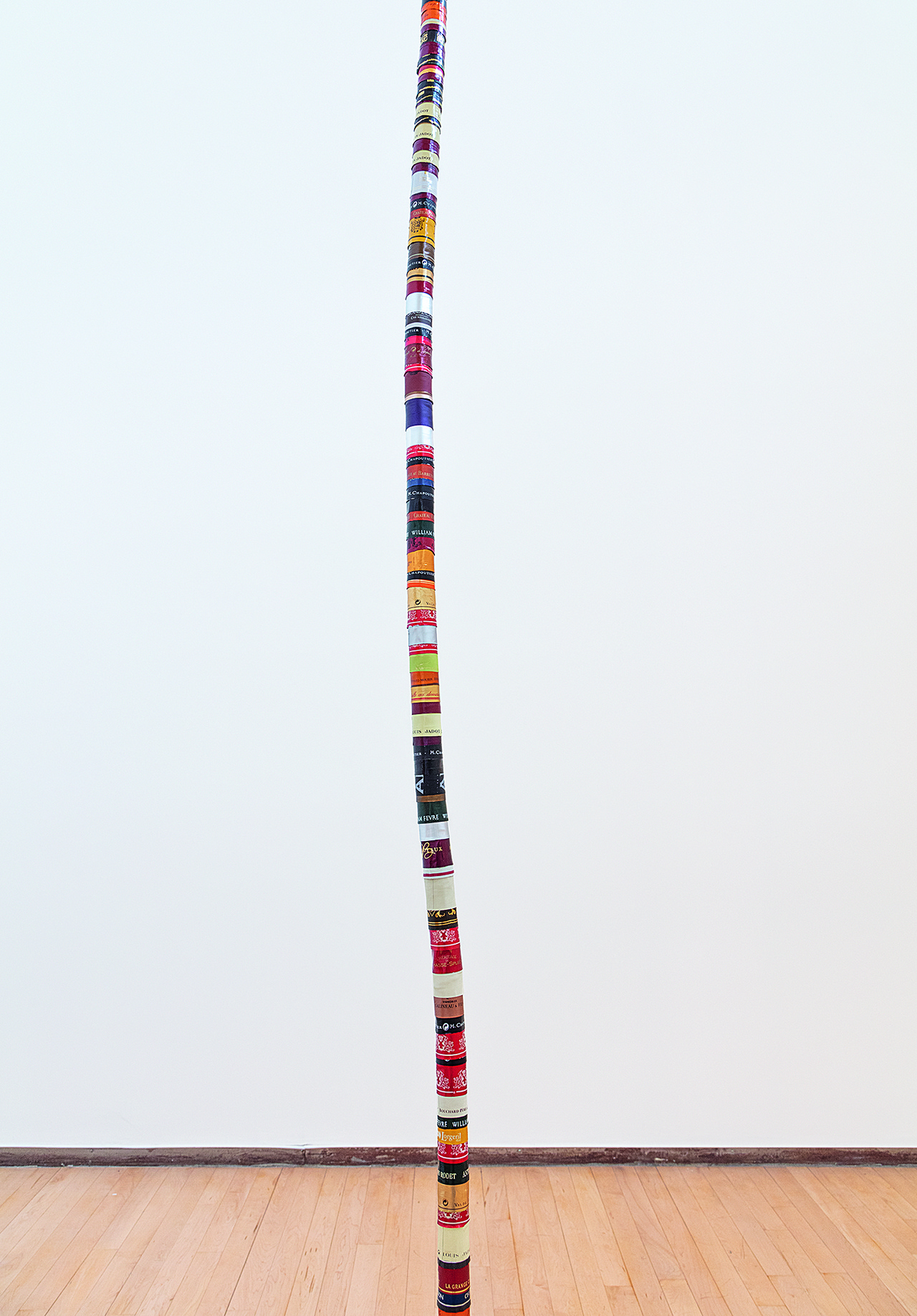
Joseph Grigely, “What the Stress Amounts To,” 2023
What about those sculptures that do have volume?
Last May at the Massachusetts Museum of Contemporary Art, Joseph Grigely installed What the Stress Amounts To (2023), a 35-foot high, 1.1-inch-diameter column of wine capsules, which are those foil caps that must first be stripped off so that a wine bottle can be uncorked. This listing tower, a seeming tribute to drink, wouldn’t let me stop thinking about André Cadere’s bars. The colorways of the contemporary wine industry, it seems, are identical to Cadere’s preferred chromatic palette of the 1970s: the deep reds, yellow-golds, greens, and whites of Cadere’s 4-inch-diameter painted and joined-together spools echo unmistakably in Grigely’s somewhat darker, much longer cylindrical tower.
Cadere first left behind his bars at others’ art shows and eventually exhibited them on their own, leaning against walls. Lily Woodruff describes them through “the cultural inappropriateness of the art object’s presence within and outside artistic contexts,” a reading that feels apt to Grigely’s own institutional-critical agendas. [9] One could easily read this tower as indexing a one-to-one ratio between stress on the artist and amounts of wine consumed by the artist – a language of signs and signifiers, with capsules as a measure of stress. One could also look at that tower as built from the detritus of wine consumed with others. Much of Grigely’s work, from Blueberry Surprise (2003), comprised of thousands of utterances he’s archived, to White Noise (2023), two pavilions lined with over 2,500 pieces of scrap paper showing Grigely’s passed notes, extend his encounters with others into archives that last for years or decades. In other words, these are not simply works that take forever to make; they are accretions of daily forms of interdependence. The interdependent, here, is part of how the work belongs to his circle of care and also to the network of friends and strangers he encounters socially. [10]
Instead of a sculpture that supposedly appears all at once, Grigely’s work constantly takes on new types of cadences. Our encounter starts to be freighted with what Lauren Berlant calls “slow death,” the endemic war of attrition waged especially on vulnerable populations. Borrowing from Michel Foucault’s understanding of endemics as “permanent factors […] [that] sapped the population’s strength,” Berlant points to “a distinction between individual life and collective living on, where living increasingly becomes a scene of the administration, discipline, and recalibration of what constitutes health.” [11] It is not that every body – especially inside art institutions, which obviously privilege certain bodies – is nonnormative. It is, rather, that nonnormative forms of being, communicating, moving, and embodying are part of how we rethink what the stress amounts to on the scale of a population.
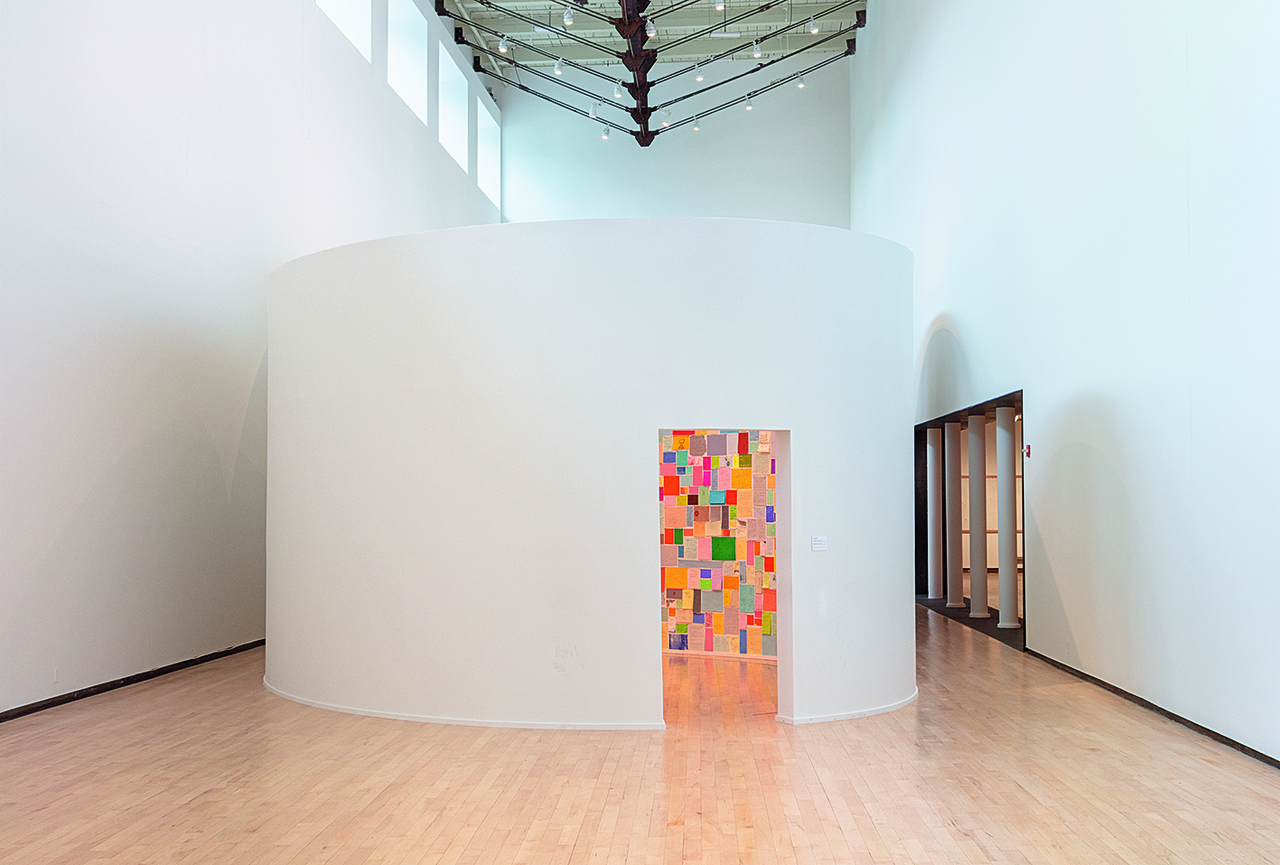
Joseph Grigely, “White Noise,” 2023
Let me back up. What the Stress Amounts To is a witty, pithy tower, rooted barely in the floor and suspended from an ultra-high atrium ceiling, well past where one could make out the mechanism of attachment. It doesn’t plunge down; it soars up.
That soaringness describes an almost nihilistic ambition. “Stress,” in the work’s title, might be pitted against “unstressed,” but it might also push at the normalization of standards of health. In other words, Grigely’s tower might not index either a singular or a collective self under stress, but rather it might aestheticize “stress.” One would have to admit such nihilistic beauty as if it were an inoculating dose, forcing us to say, This [non-body, non-proxy] that is made to soar refuses the terms on which you’ve given us “stress.” Terre Thaemlitz asks, “What if one refuses to celebrate normalization?” That is, what if one refused not-stressed as the ideal? “What if,” Thaemlitz continues, “rather than responding to the violence of being forced to self-identify as ill with a demand to be recognized as healthy, one responds with a politicization of the desire to be recognized as healthy?” [12] What if, in other words, instead of interpreting “stress” as a complaint, a negative, one saw the opportunity to refuse such standards of health? I am not arguing that the world’s populations should not rest or escape the heat; given the paucity of structured care, pathologizing the absence of rest or livable atmospheres is not helpful. If art can ever launch the weight of “cultural inappropriateness” at the forces of normalization, it will do so by changing the atmosphere. What I liked so much in Grigely’s listing tower was how the soaring pillar built elegantly upward. Its “fuck you” wasn’t particularly transgressive, but it did make what the stress amounts to feel, briefly, as if it was rising, of its own accord, into the air.
Rachel Haidu is a professor of art history at the University of Rochester. She is the author of The Absence of Work: Marcel Broodthaers, 1964–1976 (MIT Press; October Books, 2010) and Each One Another: The Self in Contemporary Art (University of Chicago Press, 2023), as well as numerous essays on modern and contemporary artists. Her current book project examines questions of transition both as a historical process and in the framework of gender and trans studies. Along with Hannah Feldman, she is coeditor of an upcoming volume tentatively entitled Touching Paper: Writing Towards Art, Love, and the Weather.
Image credit: 1. © Senga Nengudi, courtesy of Sprüth Magers and Thomas Erben Gallery, photo Ken Peterson; 2. Courtesy of Nairy Baghramian and Marian Goodman Gallery, photo Elisabeth Bernstein; 3. Courtesy of Christine Sun Kim, François Ghebaly Gallery and White Space, photo Hai Zhang; 4. + 5. Courtesy of Joseph Grigely, Krakow Witkin and Air de Paris, photo Jon Verney
Notes
| [1] | Ulrike Müller, James Coleman, Amy Sillman, and Anne Teresa de Keersmaeker, respectively. My recent book, Each One Another, is divided by medium in order to enable the cross-pollinating effects between media to play over them and also within them (painting inverted by and responding to printmaking, video and mass-market film in dialogue, etc.). |
| [2] | From Michael Fried’s canonical attack on Minimalism to David J. Getsy’s reading of “freestanding, human-scale sculptural objects that shared the proportions, frontality, and structure of the human body” to question and push past gender dimorphism, this anthropomorphism has proved critical to the discourse on sculpture. See David J. Getsy, Abstract Bodies: Sixties Sculpture in the Expanded Field of Gender (New Haven, CT: Yale University Press, 2015), 6. The reference in the following paragraph is to Flavin’s pink out of a corner (to Jasper Johns) (1963), on the front cover of Getsy’s book. |
| [3] | Of Genzken’s “fresh biomorphism,” Daniel Horn writes, “It’s as if she had reached into one of Lucio Fontana’s signature slits to extricate an airy solid from this pathological and sexualized postwar void.” Daniel Horn, “Isa Genzken: Kunstmuseum Basel,” Artforum 59, no. 6 (April 2021). |
| [4] | Liz Larner, in conversation with Mary Ceruti, in Liz Larner: Don’t Put It Back Like It Was, exh. cat., ed. Karen Kelly and Barbara Schroeder (New York: SculptureCenter; Minneapolis: Walker Art Center; Brooklyn, NY: Dancing Foxes Press, 2022), 29. |
| [5] | See Pelzer’s reading of what she calls Weiner’s “statements/sculptures,” including #534, exhibited at the Kunst Museum Winterthur since 1995, in which she describes “words [being] treated like blocks in a system of spatial weights and measures.” Birgit Pelzer, “Dissociated Objects: The Statements/Sculptures of Lawrence Weiner,” trans. John Goodman, October 90 (Autumn 1999): 82. |
| [6] | Weiner elaborates, “I see most painting, especially most successful painting, as functioning within a sculptural level as well.” Lawrence Weiner, “A Conversation with William Furlong Concerning 20 Works by Lawrence Weiner Presented in London in 1980,” reprinted in Having Been Said: Writings and Interviews of Lawrence Weiner, 1968–2003, ed. Gerti Fietzek and Gregor Stemmrich (Ostfildern-Ruit: Hatje Cantz Verlag, 2004), 110. |
| [7] | See “Christine Sun Kim Explains Her Site-Responsive Project,” art21, season 11, episode 3, PBS, aired October 20, 2023, 1:14. |
| [8] | “Art’s audiences,” here, inherit from Adrian Piper’s words: “Let’s at least be clear about one thing: this is not an empty, academic exercise. This is real. And it has everything to do with you.” Adrian Piper, “Cornered: A Video Installation Project,” in Theory in Contemporary Art since 1985, ed. Zoya Kocur and Simon Leung (Malden: Blackwell, 2005), 182–86. Cited in Andrew Blackley, “Park McArthur: Geometry, Material, Scale,” Afterall 40 (Autumn/Winter 2015): 57–58. |
| [9] | Lily Woodruff, Disordering the Establishment: Participatory Art and Institutional Critique in France, 1958–1981 (Raleigh, NC: Duke University Press, 2020), 147. |
| [10] | In the background of this idea but not exactly proper to it is the notion of conviviality developed by Jasbir Puar and adopted and investigated by artists such as Park McArthur. To be sure, conviviality in their sense is not necessarily the party from which Grigely is collecting capsules. “Conviviality, unlike notions of resistance, oppositionality, subversion or transgression (facets of queer exceptionalism that unwittingly dovetail with modern narratives of progress in modernity), foregrounds categories such as race, gender, and sexuality as events – as encounters – rather than as entities or attributes of the subject.” Grigely does not show or tell us much about the encounters he records or collects evidence from, and indeed, if anything, the notes collected in White Noise seem rather to intensify (anonymous) identities and genders. Regarding conviviality, see Jasbir Puar, “Prognosis Time: Towards a Geopolitics of Affect, Debility and Capacity,” Women and Performance: A Journal of Feminist Theory 19, no. 2 (2009): 168. See also Park McArthur, “Sort of Like a Hug: Notes on Collectivity,” first published in “Heat Island,” ed. Isla Leaver-Yap, themed issue, The Happy Hypocrite, no. 7 (2014): 48–60. |
| [11] | Lauren Berlant, “Slow Death (Sovereignty, Obesity, Lateral Agency),” Critical Inquiry 33, no. 4 (Summer 2007): 756. On disability and debility, see Jasbir K. Puar, The Right to Maim: Debility, Capacity, Disability (Raleigh, NC: Duke University Press, 2017). |
| [12] | Terre Thaemlitz, “Deproduction,” essay accompanying the album Deproduction, Comatonse Recordings, 2017; italics in the original. Available at Thaemlitz’s record label website. |

